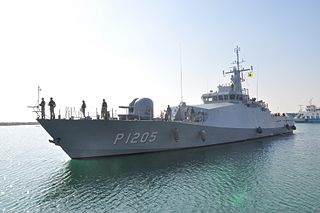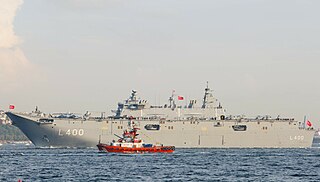Design and description
Heybeliada has a displacement of 2,300 long tons (2,340 t ), [3] is 99.56 m (326.6 ft) in length, [4] 14.4 m (47 ft) in beam, [4] and has a draft of 3.89 m (12.8 ft). [4] She is powered by two diesel engines and a gas turbine, with a power of 31,640 kilowatts (42,430 hp), driving two propellers, and is capable of speeding up to 29 knots (54 km/h; 33 mph). [5] She has a range of 3,500 nautical miles (6,500 km) at 15 knots (28 km/h; 17 mph), and has an endurance of 21 days with logistical support and ten days while operating autonomously. [5] She has a crew of 93, with space for up to 106. [5]
Heybeliada is equipped with GENESIS combat management system that controls search and navigation radars, electronic warfare suits, weapons, countermeasures, communication devices, underwater and onboard sensors. [5] The ship is armed with a single 76-millimetre (3 in) OTO Melara gun, two ASELSAN STAMP 12.7-millimetre (0.50 in) guns, eight Harpoon missiles, 21 Rolling Airframe Missiles and two 324-millimetre (12.8 in) Mark 32 triple launchers for Mark 46 torpedoes. [6] Electronic warfare systems include a dedicated EW radar, laser/RF systems, ASW jammers, and an SSTD system. [5] Communication and navigation systems involve satellite communication, X-band, navigation, fire control and LPI radar, ECDIS, GPS and LAN infrastructure. [5] The radar suite is the SMART-S Mk2, built by Thales. [7] The ship is fitted with sonar developed by the Scientific and Technological Research Council of Turkey. [6] The whole platform is managed by an advanced integrated platform management system. [5]
The ship is capable of carrying Sikorsky S-70 helicopter or unmanned aircraft, along with the associated armaments, 20 tons of JP-5 aircraft fuel, aerial refueling systems and maintenance facilities. [5]
Construction and career
The ship was designed, developed and built by the Tuzla (Istanbul) Naval Shipyard as a part of the MILGEM project. Istanbul Naval Shipyard Command started construction of Heybeliada on 22 January 2007. The ship was laid down on 22 January 2007 and launched on 27 September 2008. Sailed out for initial sea trials in 2008, she was officially commissioned by the Turkish Navy and entered navy service on 27 September 2011. [8]
Since her commissioning, her longest voyage has been 2013 Mediterranean cruise. [9] This journey took the vessel to the ports of Alexandria, [1] Tripoli, Libya, [10] Algiers, [11] La Goulette, [12] Casablanca, [13] and Durres. [14] Throughout the vagaries of her service career, the vessel has received the moniker the "Ghost of the Seas". [1]

The Turkish Naval Forces, or Turkish Navy, is the naval warfare service branch of the Turkish Armed Forces.

MILGEM project is a national warship program of the Republic of Turkey. Managed by the Turkish Navy, the project aims at developing multipurpose corvettes, frigates and destroyers that can be deployed in a range of missions, including reconnaissance, surveillance, early warning, anti-submarine warfare, surface-to-surface and surface-to-air warfare, and amphibious operations.

The G class is one of the frigate classes of the Turkish Navy. They are extensively modernized versions of ex-Oliver Hazard Perry-class guided-missile frigates of the US Navy, mainly designed for air defense with a weapons configuration that is optimized for general warfare.

The Turkish Naval Academy is a four-year co-educational military academy and part of the National Defence University. It is located in the district of Tuzla in Istanbul. Its mission is to develop cadets mentally and physically for service as commissioned officers in the Turkish Navy. It must not be confused with Naval War Institute.

The TF-2000-class destroyer is a projected anti-air warfare guided-missile destroyer currently undergoing development by the Turkish Naval Institute. The class will provide survivability in the presence of aerial threat and also support mission functions such as command, control, and communications, reconnaissance, early warning, surface warfare, anti-submarine warfare and electronic warfare. Moreover, once in service, the TF-2000s are slated to be an integral part of Türkiye's expeditionary strike groups centered around the TCG Anadolu LHD and the country's future aircraft carrier(s). The TCG Anadolu is to be followed up by the TCG Trakya light aircraft carrier and President Erdoğan has also hinted at the construction of a larger aircraft carrier that is to be designed in cooperation with Spain. These capital vessels require destroyer escorts to defend them against enemy aircraft, ships and submarines; in other words, the perfect role for the TF-2000s once these new designs are slated for operational service by 2038. On 5 December 2007, Defence Industry Executive Committee approved plans to build six ships of this class. In January 2013, it was announced that Turkey was planning to acquire a total of 8 TF-2000 destroyers, which was confirmed at the International Defence Industry Fair (IDEF) 2021. With the realization of the project, it is intended to improve the anti-air warfare (AAW) capabilities of the Turkish Navy.

The Poti class was the NATO reporting name for a group of anti-submarine warfare (ASW) corvettes built for the Soviet Navy. The Soviet designation was Project 204 small anti-submarine ships. These ships were the first Soviet warships powered by gas turbine engines; two propellers were mounted in tunnels to give a very shallow draught. A twin 57 mm (2 in) gun mounting provided self-defence. Three ships of the class were exported to Romania and six to Bulgaria during the Cold War. By 2008, all ships of the class were no longer extant.
Istanbul Naval Shipyard, also known as Pendik Naval Shipyard, is a naval shipyard of the Turkish Navy on the northeastern coast of the Sea of Marmara in Tuzla, Istanbul, Turkey. It is the largest shipbuilding facility in Turkey.

SMART-S Mk2(Signaal Multibeam Acquisition Radar for Tracking, S band Mk2) is a naval medium to long-range air and surface surveillance multibeam passive electronically scanned array 3D radar designed by Thales Nederland, formerly Hollandse Signaalapparaten (Signaal). While the original SMART-S radar was only produced in small numbers, SMART-S Mk2 is very successful. Only six years after its introduction, 30 systems were sold to navies all over the world. SMART-S Mk2 radar is equipped with transmitter/receiver (T/R) modules manufactured by Turkish defence company Aselsan. The radar transmitter/receiver (T/R) modules for the radar are purchased by Thales from Aselsan.

The Ada class is a class of anti-submarine corvettes developed primarily for the Turkish Navy during the first stage of the MILGEM project. The Turkish Navy has commissioned all four Ada-class corvettes.

The Tuzla-class New Type Patrol Boat is one of the patrol boat classes of the Turkish Navy. The Tuzla class, named after a district in Istanbul with the same name, was designed by Dearsan Shipyards to meet the operational requirements of the Turkish Navy in littoral waters. These patrol boats conduct patrol, security and anti-submarine warfare (ASW) duties in or around harbors & coastal areas.
TCG Büyükada (F-512) is the second ship of the Ada-class ASW corvettes of the Turkish Navy. TCG Büyükada was named after Büyükada Island. Büyükada Island is part of the Prince Islands archipelago in the Sea of Marmara, to the southeast of Istanbul. Its sister ship is TCG Heybeliada.

TCG Bozcaada (F-500) is the lead ship of the six Burak-class ASW corvettes of the Turkish Navy. She was named after Bozcaada Island, which is in the northern part of the Aegean Sea. Bozcaada is an ex-D'Estienne d'Orves-class A69 type aviso.

The Maharaja Lela-class frigate, also known as the littoral combat ship (LCS), is a class of six stealth frigates being built for the Royal Malaysian Navy (RMN). First announced as the Second Generation Patrol Vessel in 2011, the ships are based on an enlarged version of the Gowind-class corvette, designed by Naval Group, formerly known as DCNS of France.

TCG Anadolu (L-400) is an aircraft carrier of the Turkish Navy. It is named after the peninsula of Anatolia which forms the majority of the land mass of Turkey. The construction works began on 30 April 2016 at the shipyard of Sedef Shipbuilding Inc. in Istanbul, with the keel being laid on 7 February 2018. TCG Anadolu was commissioned with a ceremony on 10 April 2023.
The Istanbul-class frigates are a group of four multirole frigates currently being constructed for the Turkish Naval Forces. Developed under the MILGEM national warship program as the I-class frigate, the Istanbul class is an enlarged version of the Ada-class anti-submarine corvette, with enhanced endurance and MDAS Vertical Launching System (VLS) for multi-role capability. On 19 January 2017, Turkish Navy held a ceremonial steel cut for the lead ship TCG Istanbul. Istanbul was laid down on 3 July 2017 and launched on 23 January 2021.

TCG Oruçreis, is a Barbaros-class frigate of the Turkish Navy, the second ship of that class. She was named for Oruç Reis, the Ottoman Beylerbeyi of the West Mediterranean. The submarine TCG Oruç Reis was the first ship of that name in the Turkish Navy.
TCG Kınalıada (F-514) is the fourth ship of the Ada-class ASW corvettes of the Turkish Navy. Kınalıada was named after Kınalıada Island, a part of the Princes' Islands archipelago in the Sea of Marmara, to the southeast of Istanbul, Turkey.

TCG Burgazada (F-513) is an Ada-class ASW corvette of the Turkish Navy, built as the third combat ship of the MILGEM project. Burgazada was named after Burgazada Island, which is part of the Prince Islands archipelago in the Sea of Marmara, to the southeast of Istanbul.

ATMACA (Accipiter) is an all weather, long range, precision strike, anti-ship cruise missile, developed by Turkish missile manufacturer ROKETSAN. The Atmaca will enter service with the Turkish Navy to gradually replace the country's existing inventory of Harpoon missiles.
The Babur-class corvette, also known as the PN MILGEM class, is a class of four heavy corvettes under construction for the Pakistan Navy. This class is a subclass of the Turkish MILGEM project. The corvette class is heavier and larger than the Turkish Ada-class corvette and are also equipped with VLS.














